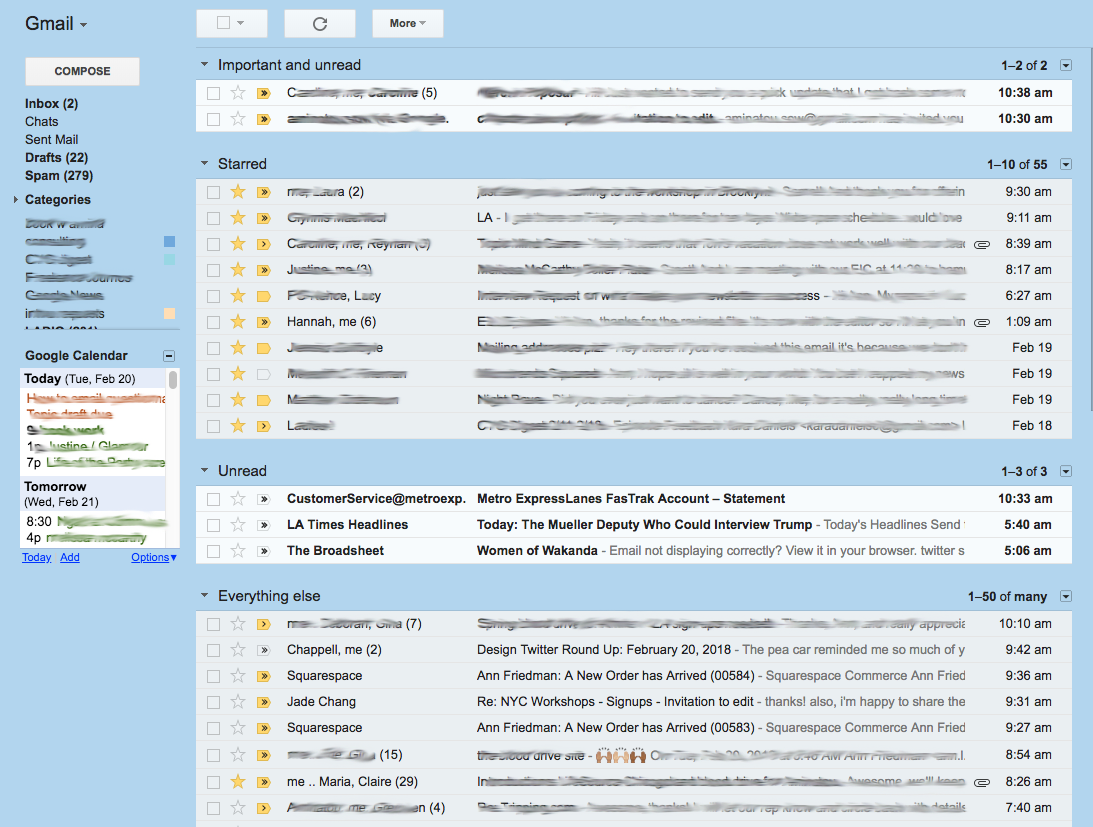How I Email: Ann Friedman, Journalist and Podcast Host
Email is a non-negotiable part of everyday life. For some, it’s an unruly time suck, but enlightened email users have systems to ensure they’re not a slave to the inbox. We’re asking smart thinkers to give us a peek inside their inboxes, share tips, ideas, gripes, and everything in between.
Ann Friedman is a journalist and cultural critic. She is a columnist for New York magazine and the Los Angeles Times, and co-hosts the podcast Call Your Girlfriend. Ann says that adding people to your email newsletter without consent is “the equivalent of barging into their house unannounced.” She told us more about her email pet peeves and offered a peek inside her inbox.
 What’s your typical email routine?
What’s your typical email routine?
I usually have my Gmail open in a tab while I’m working, unless I’m in deep-concentration mode and writing. But I don’t feel pressure to respond to every email as it comes in. I don’t believe in Inbox Zero, because it’s not achievable for more than a few hours. (If I hit Inbox Zero and stay there, that’s when I’ll know my career is over.) I think of email as a constant flow to be managed rather than something that can be zeroed out.
I use an “old” inbox view without the tabs on top, which allows me to see unread important mail up top, followed by everything that requires a reply (which I’ve already read and starred), and then unread bulk stuff below that. If I have 20-25 starred emails or less, I consider myself to be generally on top of things. So I suppose my philosophy could be called Inbox 25. At its worst, my starred-to-reply count is in the hundreds. Unless I’m on vacation, I try to read/sort email at least a few times a day, even if I don’t reply to it in the moment.
My inbox looks like this:

What mindsets or behaviors influence how you manage your inbox?
If an email contains a question that’s going to take me some time to answer or consider, I often reply just to ask when they need an answer. You’d be surprised at how often people send a concrete ask without including a timeline. Sometimes, if it’s a cold email from a stranger that is not tied to a deadline-urgent request, I’ll take months to answer. Around 3pm PST, my email traffic slows considerably when my east-coast editors go home for the day. This is often a good time for me to send some easy replies to semi-urgent stuff. For the least urgent replies, I like to use Offline Gmail on a long flight and respond to a dozen at a time.
I have email on my phone, but I do not have background-update on. I have to open the app and refresh in order to check mail. That way I don’t see the little red dot pop up, so I’m not tempted to open email only to see that some online store is having a sale. I only check when I’m expecting edits back from one of my editors or something like that.
As a journalist with a popular newsletter, you get a ton of pitches. What makes for a good pitch email?
The best pitches are tailored to the person who’s receiving them. Random email blasts get deleted right away, unread. I’m way more likely to read a pitch if it’s clear the sender has actually read my work or listened to my podcast or receives my newsletter, and has a reason for pitching me specifically. It’s also shocking how many pitches do not link to further information online. Press releases about reports, surveys, or findings should, especially, link to the same info on a website so it can be easily shared with editors, in an article, or on social media.
All good pitches are specific, timely, and clear about the value proposition for the recipient. We all know that media coverage resulting from a pitch would be great for the sender. A good pitch clarifies how that would also be great for the recipient. (On a related note, my friend Jade Chang and I are hosting a workshop for writers in early April on how to effectively pitch editors!)
Do you have any email pet peeves?
I bristle when someone expects a quick response to a cold email. If a person emails me asking for advice or posing a non-urgent question, and then sends a snippy reply when I’ve failed to answer after a week, I get upset. In general, I treat cold emails like a phone call: Just because it’s ringing doesn’t mean I have to pick up and say hello. If I do decide pick up, I will do so at my leisure.
I also get very angry when people auto-subscribe me to their newsletters. This is true for online shops that don’t allow for easy opt-out from their email list as you’re checking out, it’s true for PR/marketing shops, and it’s very true for people sending personal newsletters. Auto-enrolling people is the equivalent of barging into their house unannounced. Don’t do it. The only person I subscribed to my newsletter without their consent was my own mother.